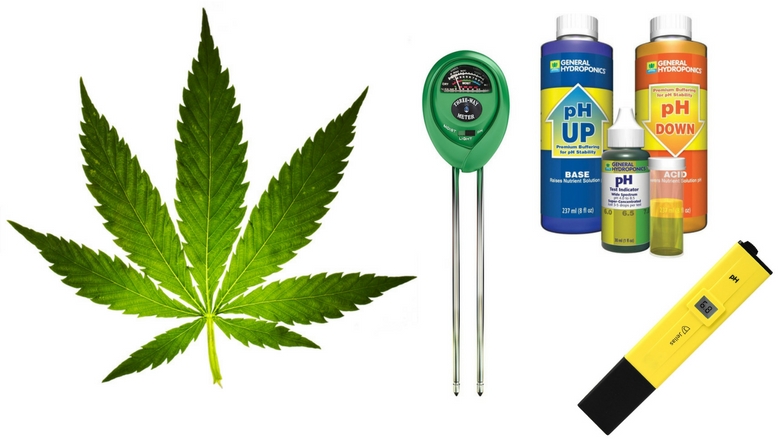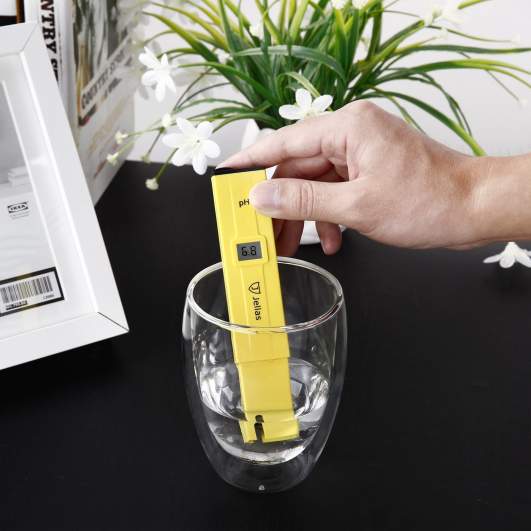
Growing cannabis, both indoors and outdoors, takes a lot of attention. Cannabis plants require a very specific environment and growing conditions, and these change for each stage of their life cycle. pH for hydrophonics is one of the most important factors in growing healthy, productive cannabis plants.
It is true that marijuana grows “like a weed,” but in order to produce big, juicy buds you need to follow some strict guidelines. Everything must be monitored and kept at the ideal level, from temperature and humidity to CO2, lighting, water and nutrient solution, and of course, pH.
pH affects nutrient uptake, plant vitality and pest resistance, and can negatively impact your yields if you have not been keeping an eye on pH levels throughout the plants’ growth stages.
In this article, I’ll go over the basics of testing and adjusting pH in both soil and hydroponic grow operations. Adjusting pH in hydroponics is simple, and will become part of your daily routine. Your plants will thank you!
pH In Soil Vs Hydroponics
Soil and hydroponics have slightly different requirements for pH when it comes to growing cannabis. Factors such as the makeup of nutrient solutions as well as microorganisms in soil can affect the pH that is needed for each environment.
Many nutrients, especially in hydroponics, claim to be”pH balancing” and advertise that you do not need to adjust the pH of your grow when you use their nutrients. This is very misleading and should always be taken with a grain of salt. Properly balanced nutrient solution will not have as strong of a fluctuation in pH as lower quality products, but you still do need to check and adjust regularly because even small fluctuations can affect your grow.
So how does pH actually affect your plants’ health? pH is a way of measuring the acidity of your nutrient solution or soil. pH stands for Potential Hydrogen, and is actually the measure of hydrogen ions within a solution. The pH scale goes from 0 to 14 – Low numbers are acidic, high numbers are alkaline, and 7 is neutral. Acidic substances, which cause pH to drop, increase the hydrogen ion concentration in the solution.
Substances that cause pH to rise are basic, or alkaline. Buffers are substances that increase the stability of a solution, and keep the pH from fluctuating wildly when an acid or base is added. Buffers are often added to nutrient solutions.
If the pH of your nutrient solution or soil is too acidic or too alkaline, the roots of your plants will not be able to absorb nutrients as efficiently as they should. pH can be affected not only by adding substances to a solution, but by your water quality and also by lighting.
In very strong light, plants tend to absorb more Nitrogen, which causes pH to rise as nitrogen is removed from the solution. In low light, plants absorb more Phosphorous and Potassium, therefore causing the pH to drop as these nutrients are taken out of the solution. Because lighting schedules change from high light to lower light when you switch from vegetative to flowering growth, you may experience pH fluctuation during the switch.
How to Check and Adjust pH In Soil and Hydroponics
Cannabis plants grown in soil, both indoors and outdoors, require a pH level of between 6 to 7. Plants grown outside of this ideal range may start to show signs of nutrient deficiency such as discoloration or spots on the leaves. Nutrients such as Nitrogen, Phosphorous, Calcium, Iron, Magnesium and more are all absorbed best at a pretty neutral pH in soil.
Maintaining proper pH becomes especially important when you use liquid nutrients in soil. If you are using only organic soil amendments such as manure and compost, adjusting pH is not as crucial because you do not risk the rapid fluctuations that can happen when you use liquid nutrients. Make sure to check the pH at least every time you add nutrient solution.
Cannabis plants grown in hydroponics are much more vulnerable to changes in pH, because they rely on nutrient solution for all of their fertilization needs. Cannabis grown in hydroponic systems prefers a slightly more acidic pH of between 5.5 to 6.5. Professional growers usually shoot for pH within this range, instead of always trying to adjust to a very specific number.
Optimal nutrient absorption varies for each major nutrient that cannabis plants require. The optimal pH for absorption is much more variable in hydroponics than it is in soil. If you allow for a range between 5.5 to 6.5 instead of always adjusting to the exact same number, you will allow for greater absorption across the board.
Testing pH is easy, but a slightly different process for soil and hydroponics. We’ll get in to the specifics for each below, as well as how to adjust the pH once you have tested.
Best Soil pH Tester: HealthyWiser 3-in-1 Soil Test Kit For Moisture, Light & pH

Testing pH in soil is an easy process with the right tools. This inexpensive soil pH tester is a three in one tool, so it will also give you the moisture levels and light level of your plants. This pH tester works with an easy switch that lets you go in between the three modes.
Simply move the switch to the pH setting, dip the testing rods into the soil, and allow the lever to move until it has stopped. Whatever number it stops on is your current pH. This is not quite as accurate as a liquid pH tester, but as long as your arrow is beneath the 7 and above the 6 you are in the proper range.
Price: $12.99
Buy the HealthyWiser 3-in-1 Soil Test Kit For Moisture, Light & pH? here.
Best Hydroponics pH Tester: Jellas pH Meter

This pH for hydrophonics tester from Jellas is a best seller. It is incredibly accurate within 0.1 and is very easy to use. You can operate this pH tester with the touch of a switch, and the LCD display quickly tells you the pH.
This pH tester is pocket sized, so you can easily carry it around from room to room. It also comes with a carry case for safe storage. To use this pH tester, simply dip the bottom end into your nutrient solution and move the switch on top to the ON position. A number will show up on the display to tell you the pH. It is as simple as that!
Price: $15.99
Buy the Jellas pH Meter here.
Best pH Up and Down Solution: General Hydroponics pH Control Kit

If you have ever been in a cannabis grow room, chances are you will recognize these hydroponic pH stabilizer products right away. Growers have varied preferences when it comes to just about everything from nutrient solution to lights, but almost every grower I have ever known uses the General Hydroponics pH Control Kit. This inexpensive kit includes pH Up, pH Down and text indicator liquid.
Using pH Up and Down is easy. After you test your pH, you will know whether you need to make your solution more acid or alkaline. The most important thing to remember is that you never want to add pH Up or Down to your nutrient solution directly. Doing this can cause nutrients to precipitate, or it can change the pH too quickly to a point where you may need to throw out your solution entirely and start over from scratch.
Instead, add a little bit at a time to plain water, stir well to make sure it is dissolved, and then add this to the solution. Make sure you stir it very well so that it is completely dissolved before testing again.
pH Down is extremely potent. In general, you need about one mL per gallon to reduce the pH by one point. If you have soft water, pH down is very effective in small doses. If you have hard water, you may need to add more. pH Up is less strong and you will need to add a lot more in order to have an effect, usually between two to four mL in order to raise pH by one point.
When you first start out adjusting your pH for hydrophonics it can take a few tries to get it right. Add the solutions in very small amounts, but write down these amounts until you have the pH at the level you need. If you keep a record you can get a good idea of how much is usually needed with your particular water, and the adjustments will become a lot faster.
Price: $15.63
Buy the General Hydroponics pH Control Kit here.
See Also:
- Best Hydroponic Watering Systems for Growing Cannabis
- Best Temperature & Humidity Controllers for Growing Cannabis

Comments
How to Control pH for Hydrophonics in Cannabis (2018)